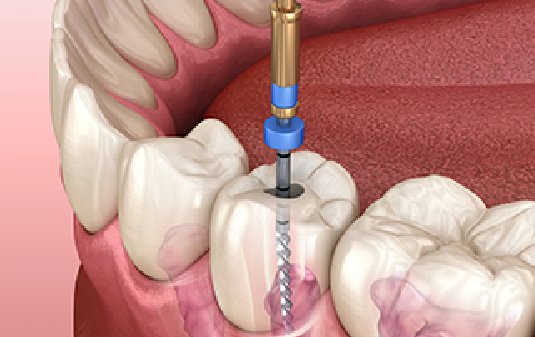There are many patients who believe that once an infection has gotten into the center of your tooth, the only option is to remove the tooth. However, the tooth may be salvageable with root canal therapy. This is the process of removing the infected tooth pulp, which also removes the infection.
Once the infection is removed, the inside of the tooth will be disinfected, and a biocompatible material will be added. This will protect the structure of the tooth from the inside. Typically, Dr. Yael Kryzman at Palisades Dental Center can help you decide which option is best for you. In this blog you will learn about Root Canal Before and After treatment.
How Do You Know if You Need a Root Canal?
There are several signs/symptoms that you may need to schedule a root canal consultation, including:
- Persistent/chronic toothache
- Tooth discoloration
- Chipped/cracked tooth
- Abscess
- Sensitivity to sweets and/or hot or cold foods/beverages
- Swelling near the affected tooth
- Loose (mobile) tooth


7 Common Causes of Toothache
There are several common causes of toothache, including:
- Cavities/tooth decay
- Chronic bruxism
- Dental abscess
- Root fracture
- Wisdom teeth
- Sinus infection/allergies
- Health conditions such as herpes simplex, canker sores, etc.
The Longer You Wait Might Be Too Late
A toothache is an indication that you have a dental problem. If addressed right away, the tooth may be saved with a simple procedure such as a dental filling. However, as the problem progresses, you may end up needing root canal treatment. If ignored further, in many situations, the only option is extraction.
Stage One: White spots
The outer layer of your teeth is known as enamel, which is made up of minerals and is the hardest tissue in your body. However, as your teeth are exposed to the acids that are produced by plaque, mineral loss occurs- which causes white spots to appear on your teeth. This is the first sign of tooth decay.
Stage Two: Enamel decay
If left untreated, the white spots will begin to turn brown. This indicates further breakdown of the enamel. This is when cavities will begin to form. A cavity must be filled by your dentist.
Stage Three: Dentin decay
Stage Four: Involvement of pulp
The tooth pulp is the very center of the tooth that contains blood vessels and nerves that keep the tooth healthy. When tooth decay progresses into the pulp, it will become irritated and may swell. Since there is nowhere for the tissue within the tooth to expand, the swelling puts pressure on the nerves, which can cause pain.
Stage Five: Abscess Formation
If the decay is left untreated, an infection can develop, forming a pocket of pus at the base of the tooth along the gumline. This is known as a dental abscess. An abscess can cause:
Severe pain
Swelling of gums, face, and jaw
Swollen lymph nodes
Fever
An abscess requires prompt treatment. If ignored, an infection can spread to other parts of your body and can be life-threatening. In many cases, once the infection has spread this far, extraction is the only option.
Stage Six: Tooth loss
Depending on how far the decay has advanced, extraction may be the best, and sometimes the only, option. However, in some cases, root canal treatment can salvage the structure of the natural tooth.
What is the Root Canal Recovery Time?
Since everyone is different, recovery time varies from one patient to another. Many patients find that pain is typically mild and resolves after about 24 hours. Overall recovery takes about a week, depending on your body’s ability to heal. If you are still experiencing pain after a week, you should contact the dentist right away- chances are that something is not right with the treated tooth.
Choosing Palisades Dental Care
If you have a tooth that is bothersome, you may benefit from root canal treatment. The dentists at Palisades Dental Care can help. Our lead dentist, Dr. Yael Kryzman, was nominated as Bergen County’s Top Dentist for 2023. She strives to incorporate the latest in dental technology into her practice, as well as create a welcoming environment, and personalized services including family, periodontal, and cosmetic procedures.
We are located on East Madison Avenue in Dumont. Our office hours are Monday from 9:00 AM to 6:00 PM, Tuesday from 8:00 AM to 6:00 PM, Wednesday from 12:00 PM to 6 PM, Thursday from 11:00 AM to 7:00 PM, and Friday from 8:00 AM to 2:00 PM. We are available on Saturdays for emergency appointments.
Root Canal FAQs
If you have any questions or concerns about root canal treatment, Dr. Kryzman will be glad to address those at any time. Below are some of the most common questions we’ve gotten about root canal therapy.
How long does a root canal take?
A root canal procedure can take anywhere from about 30 minutes to 90 minutes, depending on the location and complexity of the tooth. On average, you can expect to spend up to 3 hours at the office.
Do root canals hurt?
Many years ago, root canal treatment was a moderately painful procedure. However, thanks to advancements in anesthesia and dental technology, the procedure is about as painful as a tooth extraction. Of course, much of this depends on your tolerance to pain- some people have more tolerance than others.
How to avoid root canal treatment?
While there’s no way to guarantee that you can avoid root canal treatment, the best way to improve your chances of avoiding this procedure is by taking proper care of your teeth.
Can you eat after a root canal?
Yes, you can eat after root canal treatment. However, you need to wait until the anesthesia wears off to avoid biting and injuring your cheek, tongue, or lips.
Can you smoke after a root canal?
Smoking can be detrimental to your oral and overall health. Therefore, it’s best to stop smoking if possible. If you need help, we will be happy to offer some tips. However, if you cannot give it up, we recommend that you wait at least 72 hours.
How long does a root canal last without a crown?
A tooth treated with root canal treatment should be protected with a dental crown. If you do not have a dental crown put on the tooth, it may not last very long.
Can you drive after a root canal?
Typically, patients are given local anesthesia, which just numbs the affected area- so you should be fine to drive following root canal treatment. However, if you have sedation, you should have someone with you to drive you home.


